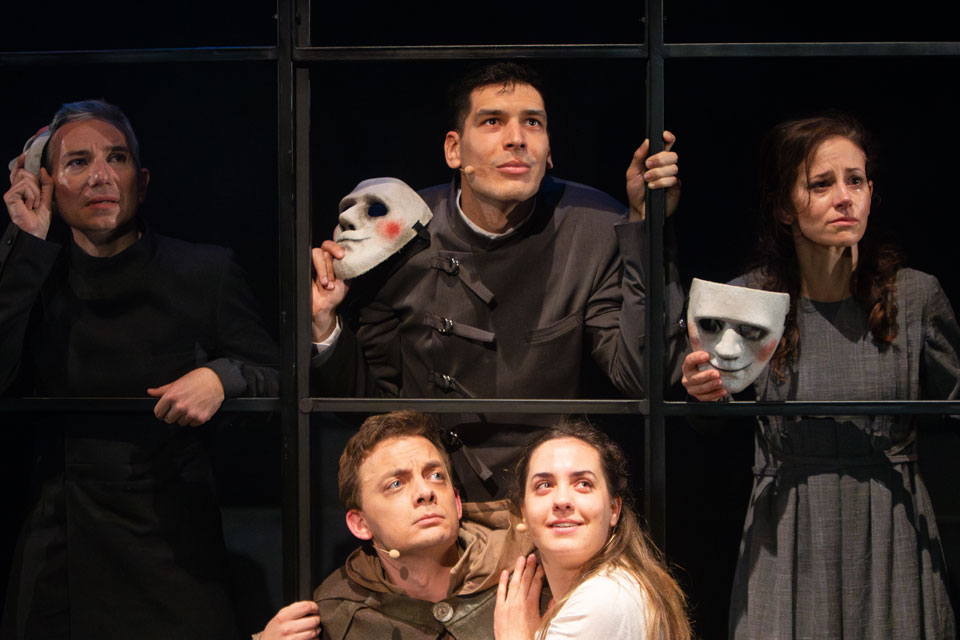Darkness. Applause echoes as the floodlights come on, revealing the cast bowing to the audience. Fists raised in defiance, a whistle blown—this closing tableau isn't just a curtain call; it’s a symbolic gesture. The applause intensifies, not just in admiration for the performance, but in recognition of its political stance.
Six months into the ongoing student and civil protests in Serbia, theater has become a platform for subtle (and not-so-subtle) acts of resistance. Many ensembles have voiced solidarity with the demonstrators, often through gestures that feel tacked onto plays unrelated to the struggle. But the Youth Theater’s new production of Dragon, directed by Russian artist Lyudmila Fyodorova, is different. Here, the message of rebellion is embedded in the very DNA of the play.
Schwartz’s Dragon, written in 1943, is an adult fairy tale with sharp allegorical teeth. Set in a fictional city long ruled by a brutal, three-headed dragon, the story casts tyranny not as a sudden imposition, but as a deep-rooted system. The dragon can shift into human form, symbolizing the fluid, pervasive nature of authoritarianism. While Schwartz originally wrote the piece as a satire of Nazism, Soviet authorities recognized its broader critique of dictatorship and banned its 1944 Moscow premiere. That alone speaks to the enduring potency of the play.
What makes Dragon especially relevant today is its critique of passive complicity. The oppressed citizens have grown so used to their chains that they maintain them willingly—offering young girls as sacrifices, justifying repression for the sake of “stability.” This “stabilocracy,” as the term might suggest, reflects not just historical fascism but eerily mirrors modern autocratic tendencies, including those in present-day Serbia. Enter Lancelot, the traveling knight, who aims to free the city—not just from the dragon, but from the apathy that sustains it.
Fyodorova’s direction emphasizes this allegory unapologetically. The fairy-tale aesthetic takes a back seat to stark symbolism. Andrej Zaparoški’s set is dominated by a looming metal cage—more prison than palace. Puppetry, masks, and stylized movements are used to chilling effect. Citizens wear pale, ghostlike masks with hints of rouge, appearing as zombified followers (bots, or maybe ćaci?). Elsa, the chosen sacrifice and Lancelot’s love interest, is literally caged, her presence split between a live actress (Ksenija Mitrović) and a marionette version of herself animated by Neda Danilović and Slavica Vučetić. This duality reinforces her powerlessness.
Interestingly, the most complex character is not the hero, but the villain. While Aleksa Ilić plays Lancelot with the firm resolve of a classic fairytale hero, the dragon appears in three haunting forms: as a decrepit, masked elder (body by Marija Radovanov, voice by Ivan Đurić); as a grotesque puppet head (manipulated by Slobodan Ninković and Uroš Lazović); and finally, in a disturbingly human form portrayed by Đurić himself. This multifaceted portrayal underscores how tyranny can shift, hide, and re-emerge.
The mayor, the dragon’s sycophantic deputy, is another standout. Saša Latinović gives a bravura performance, channeling a character who feigns madness to dodge responsibility. He’s manipulative, eccentric, and disturbingly familiar. Lines like “Son, I’m the mayor. I haven’t been telling myself the truth for years,” land with uncomfortable resonance. However, the portrayal is not without issue: the character’s supposed madness is partly symbolized through transvestism and feminized traits, a problematic trope that inadvertently stigmatizes gender nonconformity. This misstep implicates the director, performers, and costume design alike.
Gender representation more broadly remains a weak spot—rooted not in this production’s choices but in Schwartz’s original text. Female characters are passive, victimized, or peripheral, while men dominate both oppression and liberation. Only a radical reimagining of the script could have altered this, but it remains a limitation that shouldn’t be overlooked.
Politically, Dragon doesn’t stop at a simple good-vs-evil arc. After the dragon is slain, Lancelot returns a year later only to find the people still trapped—this time under the mayor’s tyranny. As the mayor chillingly observes, “The deceased trained them to drive anyone who took the reins.” The dragon may be dead, but his ideology lives on in the minds of the people. In the final moments, a mass of masked citizens stares directly at the audience—a stark, accusatory reflection. And yet, hope glimmers. Lancelot is still here. The chirping of a bird breaks the silence. The actors remove their masks and turn toward the sound of life. It’s a direct, if slightly on-the-nose, symbol of change. But it works.
In this turbulent moment for Serbia, Dragon doesn’t just reflect the times—it engages with them. It reminds us that the battle against autocracy isn’t only external. It’s a psychological struggle, too, against the violence and fear that settle into the soul. Real change takes time. But as this production makes clear, it is possible—and worth fighting for.
Borisav Matić




